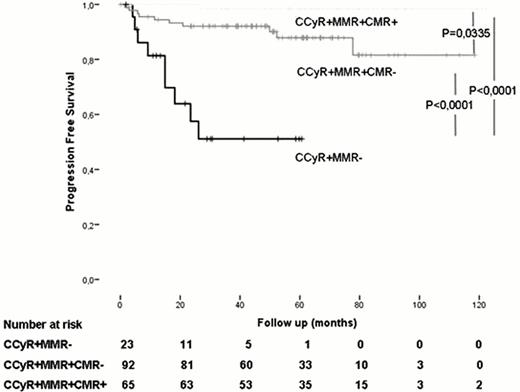Abstract
Abstract 3754
Imatinib (IM) has dramatically improved the prognosis of chronic myeloid leukaemia (CML) patients. Some of them will achieve a so-call complete molecular remission (CMR) that allows when it is sustained treatment discontinuation without relapse.
Aims of this study were i) to evaluate the frequency of CMR in IM de novo CML-CP patients, ii) to identify baseline and ongoing predictive factors of CMR in patients who had achieved a complete cytogenetic response (CCyR) on IM therapy, iii) to assess if achieving a CMR with IM frontline therapy is associated with a better event and progression-free survival.
Unselected CML chronic phase patients under frontline IM therapy were considered. CMR was defined as undetectable BCR-ABL transcript with sensitivity of at least 4·5 log on two consecutive analyses at least two months apart.
Event-free survival (EFS) referred to survival without loss of complete hematologic response, loss of complete CCyR, detection of a BCR-ABL domain kinase point mutation associated with a high level of IM resistance, progression to accelerated or blastic phase, death of any cause on or off therapy, off treatment for toxicity. Progression-free survival (PFS) referred to survival without events previously described with the exception of treatment cessation for toxicity. EFS and PFS and overall survival were measured from the date of the first CCyR on therapy to the date of event.
Among patients who failed to achieve a CMR, patients with a follow-up lower than the observed median time to CMR and without any reported event were excluded for the identification of predictive factors of CMR and survival studies .
266 patients diagnosed with CML-CP and treated with IM frontline were included between July 2000 and June 2010. The median age was 56 years (range 17–89), 160 (60%) were male. 86% of the patients received an initial IM daily dose of 400 mg. Sixty-five (24%) patients had IM dose increase to at least 600 mg. The median follow-up was 4,43 years (range 0.79–10 .8). At the time of the analysis 88 (33%) patients had stopped IM.
Two hundred and thirty three patients achieved a CCyR while on IM. Among them, 35 (13%) had a CCyR without major molecular response (MMR), 133 (50%) a CCyR with MMR without CMR, 65 (24%) a CCyR with CMR. The median time to CMR was 32.7 months (range 2.6 to 87.9). Forty six out of the 65 patients (70%) were still in CMR at the last follow-up with a median duration of CMR of 35.4 months (range, 4.1 to 91.5 months). For patients who achieved a CMR, the probability of remaining in CMR at two years is 68%.
Twelve out of 35 patients of the CCyR+MMR- group, 41 out of 133 patients of the CCyR+MMR+CMR- group had a follow-up below the observed median time to CMR and without any reported event during follow-up were excluded for the identification of CMR predictive factors and survival studies.
In multivariate analysis, spleen enlargement below the costal margin at diagnosis was negatively associated with the achievement of a CMR (HR:0.354 CI95%:0.192–0.654; p=0.0009) while shorter time from IM start to the first CCyR (CCyR before or after 12 months, HR:0.5; IC95%:0.27–0.95; p=0.034) and MMR (before or after 12 months; HR:0.2147;IC95%:0.092–0.5; p=0.00038) were strongly associated with the probability of achieving a CMR.
Patients who achieved a CMR had a better EFS and PFS than those with CCyR irrespective of MMR status (95.2% vs 64.7% vs 27.7% p=0.00124; 98.4% vs 82.3% vs 56% p=0.0335) (figures 1a and 1b). Overall survival was not different between the 3 groups.
Event-free survival of patients who achieved CCyR without MMR (n=23) (CCyR+MMR-), CCyR with MMR without CMR (n=92) (CCyR+MMR+CMR-) and CCyR with CMR (n=65) (CCyR+MMR+CMR+) on IM therapy.
Event-free survival of patients who achieved CCyR without MMR (n=23) (CCyR+MMR-), CCyR with MMR without CMR (n=92) (CCyR+MMR+CMR-) and CCyR with CMR (n=65) (CCyR+MMR+CMR+) on IM therapy.
Progression-free survival of patients who achieved CCyR without MMR (n=23) (CCyR+MMR-), CCyR with MMR without CMR (n=92) (CCyR+MMR+CMR-) and CCyR with CMR (n=65) (CCyR+MMR+CMR+) on IM therapy.
Progression-free survival of patients who achieved CCyR without MMR (n=23) (CCyR+MMR-), CCyR with MMR without CMR (n=92) (CCyR+MMR+CMR-) and CCyR with CMR (n=65) (CCyR+MMR+CMR+) on IM therapy.
This study points out that once patients achieve a CCyR on IM therapy, achieving a further deeper molecular response is associated with a better EFS and PFS, CMR confering the best outcome.
Etienne:Novartis: Consultancy, Membership on an entity's Board of Directors or advisory committees; Bristol-Myers Squibb: Consultancy, Membership on an entity's Board of Directors or advisory committees; Pfizer: Membership on an entity's Board of Directors or advisory committees. Nicolini:Novartis Pharma: Consultancy, Honoraria, Membership on an entity's Board of Directors or advisory committees, Research Funding; Bristol-Myers Squibb: Consultancy, Honoraria, Membership on an entity's Board of Directors or advisory committees; Pfizer: Membership on an entity's Board of Directors or advisory committees; ARIAD: Consultancy, Membership on an entity's Board of Directors or advisory committees; Teva: Consultancy, Membership on an entity's Board of Directors or advisory committees. Mahon:Novartis Pharma: Consultancy, Honoraria, Research Funding; Bristol-Myers Squibb: Consultancy, Honoraria; Pfizer: Consultancy.
Author notes
Asterisk with author names denotes non-ASH members.



This feature is available to Subscribers Only
Sign In or Create an Account Close Modal